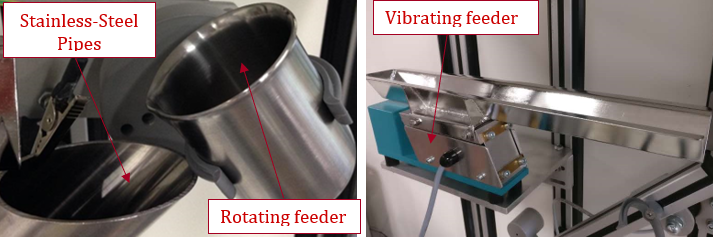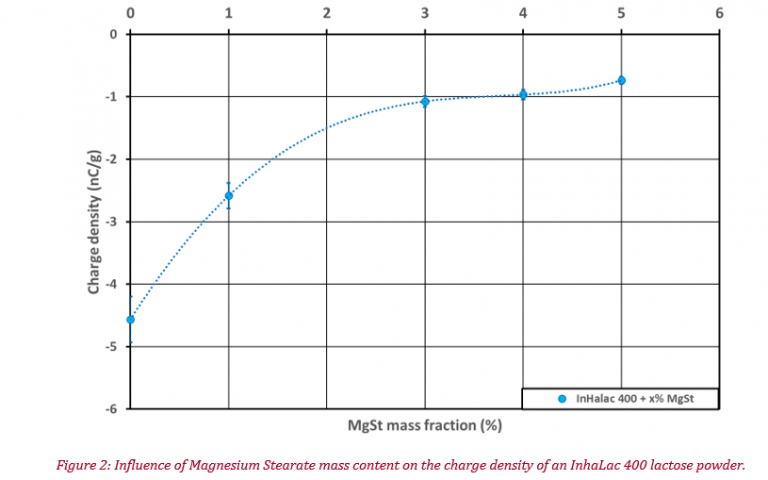Application notes
Influence of Magnesium Stearate content on the electrical charge of a lactose product
Electrostatic charges are created inside a powder during a flow. This apparition of electric charges is due to the triboelectric effect, which is a charge exchange at the contact between two solids...

Introduction
Generalities
Granular materials and fine powders are widely used in industrial applications. To control and to optimize processing methods, these materials have to be precisely characterized. The characterization methods are related either to the properties of the grains (granulometry, morphology, chemical composition, …) and to the behaviour of the bulk powder (flowability, density, blend stability, electrostatic properties, …). However, concerning the physical behaviour of bulk powder, most of the techniques used in R&D or quality control laboratories are based on old measurement techniques.
During the last decade, we have updated these techniques to meet the present requirements of R&D laboratories and production departments. In particular, the measurement processes have been automatized and rigorous initialization methods have been developed to obtain reproducible and interpretable results. Moreover, the use of image analysis techniques improves the measurements precision.
A range of measurement methods has been developed to cover all the needs of industries processing powders and granular materials. However, in this application only the GranuCharge instrument will be presented: GranuCharge to measure powder electrostatic properties.
LEARN MORE ABOUT THE GRANUCHARGE
GranuCharge
Electrostatic charges are created inside a powder during a flow. This apparition of electric charges is due to the triboelectric effect, which is a charge exchange at the contact between two solids. During the flow of a powder inside a device (mixer, silo, conveyor, …), the triboelectric effect takes place at the contact between the grains and at the contact between the grains and the device. Therefore, the characteristics of the powder and the nature of the material used to build the device are important parameters.
GranuCharge instrument measures automatically and precisely the quantity of electrostatic charges created inside a powder during a flow in contact with a selected material. The powder sample flows inside a vibrating V-tube and fall in a Faraday cup connected to an electrometer. The electrometer measures the charge acquired by the powder during the flow inside the V-tube. In order to obtain reproducible results, a rotating or a vibrating device is used to feed the V-tube regularly.
Selected powders
One lactose powder was selected: InhaLac 400. This product was provided by Meggle Pharma®. InhaLac is a high quality crystalline lactose powder, designed for DPIs (Dry Powders Inhalers).

In this application note we decided to study the influence of an anti-static agent: Magnesium Stearate. Five different blends were considered, with a different Magnesium Stearate mass fraction: 0, 1, 3, 4 and 5%.
GranuCharge analysis
Experimental protocol
The triboelectric effect of the powders was investigated with the help of GranuCharge instrument.
LEARN MORE ABOUT THE GRANUCHARGE
For each experiment with the GranuCharge, Stainless-Steel 316L pipes and vibrating feeder were used:

Figure 1: Photography of the vibrating/rotating feeder and stainless-steel pipes
The quantity of powder used for each measurement was 20-30g and the powder was not reused after a measurement.
All powders were analysed under standard conditions (43.0%RH and 21.2°C).
At the beginning of the test, the initial powder charge density (qi, in nC/g) is measured by introducing powder inside the Faraday cup. Once this step is completed, the powder is poured inside the rotating feeder, and then the experiment starts. The final charge density is measured at the end of experiment (qf, nC/g).
Table 1 summarizes all the results obtained with the GranuCharge instrument. The charge density variation corresponds to the difference between final charge (qf) and initial charge (q0) densities (∆q=qf- q0, in nC/g):
| MgSt Content (%) | Δq (nC/g) |
|---|---|
| 0 | -4.567 |
| 1 | -2.584 |
| 3 | -1.075 |
| 4 | -0.967 |
| 5 | -0.738 |
Table 1: Synthesis of the results obtained with the GranuCharge instrument
The following chart represents the charge density variation versus the Magnesium Stearate mass fraction (in %). Straight line is displayed just to guide the eye:

Figure 2: Influence of Magnesium Stearate mass content on the charge density of an Inhalac 400 lactose powder
Results Interpretation
Figure 2 is interesting, because its highlight the influence of the Magnesium Stearate addition on the electrical charge acquire by InhaLac 400 after a flow in contact with Stainless-Steel 316L pipes. As we can see, if only the Inhalac 400 product is used, the powder is highly sensitive to electrical charges (∆q = -4.6nC/g). However, when we increase the Magnesium Stearate mass fraction we can see a decrease in the charge density variation. Moreover, above a Magnesium Stearate mass fraction close to 3% a plateau is reached (charge density variation close to -0.750nC/g).
LEARN MORE ABOUT THE GRANUCHARGE
Conclusions
- The influence of Magnesium Stearate addition on the electrical charge of an Inhalac 400 product can be easily highlighted with the GranuCharge instrument;
- With only 3% of Magnesium Stearate, we manage to limit electrostatic charges build up after a flow in contact with Stainless-Steel 316L pipes;
- Therefore, this instrument is highly sensitive, accurate (average error close to 7.8%) and it can quantify the formulation of the product.
References
Cascade of granular flows for characterizing segregation, G. Lumay, F. Boschin, R. Cloots, N. Vandewalle, Powder Technology 234, 32-36 (2013).
Combined effect of moisture and electrostatic charges on powder flow, A. Rescaglio, J. Schockmel, N. Vandewalle and G. Lumay, EPJ Web of Conferences 140, 13009 (2017).
Compaction dynamics of a magnetized powder, G. Lumay, S. Dorbolo and N. Vandewalle, Physical Review E 80, 041302 (2009).
Compaction of anisotropic granular materials: Experiments and simulations, G. Lumay and N. Vandewalle, Physical Review E 70, 051314 (2004).
Compaction Dynamics of Wet Granular Assemblies, J. E. Fiscina, G. Lumay, F. Ludewig and N. Vandewalle, Physical Review Letters 105, 048001 (2010).
Effect of an electric field on an intermittent granular flow, E. Mersch, G. Lumay, F. Boschini, and N. Vandewalle, Physical Review E 81, 041309 (2010).
Effect of relative air humidity on the flowability of lactose powders, G. Lumay, K. Traina, F. Boschini, V. Delaval, A. Rescaglio, R. Cloots and N. Vandewalle, Journal of Drug Delivery Science and Technology 35, 207-212 (2016).
Experimental Study of Granular Compaction Dynamics at Different Scales: Grain Mobility, Hexagonal Domains, and Packing Fraction, G. Lumay and N. Vandewalle, Physical Review Letters 95, 028002 (2005).
Flow abilities of powders and granular materials evidenced from dynamical tap density measurement, K. Traina, R. Cloots, S. Bontempi, G. Lumay, N. Vandewalle and F. Boschini, Powder Technology, 235, 842-852 (2013).
Flow of magnetized grains in a rotating drum, G. Lumay and N. Vandewalle, Physical Review E 82, 040301(R) (2010).
How tribo-electric charges modify powder flowability, A. Rescaglio, J. Schockmel, F. Francqui, N. Vandewalle, and G. Lumay, Annual Transactions of The Nordic Rheology Society 25, 17-21 (2016).
Influence of cohesives forces on the macroscopic properties of granular assemblies, G. Lumay, J. Fiscina, F. Ludewig and N. Vandewalle, AIP Conference Proceedings 1542, 995 (2013).
Linking compaction dynamics to the flow properties of powders, G. Lumay, N. Vandewalle, C. Bodson, L. Delattre and O. Gerasimov, Applied Physics Letters 89, 093505 (2006).
Linking flowability and granulometry of lactose powders, F. Boschini, V. Delaval, K. Traina, N. Vandewalle, and G. Lumay, International Journal of Pharmaceutics 494, 312–320 (2015).
Measuring the flowing properties of powders and grains, G. Lumay, F. Boschini, K. Traina, S. Bontempi, J.-C. Remy, R. Cloots, and N. Vandewall, Powder Technology 224, 19-27 (2012).
Motion of carbon nanotubes in a rotating drum: The dynamic angle of repose and a bed behavior diagram, S. L. Pirard, G. Lumay, N. Vandewalle, J-P. Pirard, Chemical Engineering Journal 146, 143-147 (2009).
Mullite coatings on ceramic substrates: Stabilisation of Al2O3–SiO2 suspensions for spray drying of composite granules suitable for reactive plasma spraying, A. Schrijnemakers, S. André, G. Lumay, N. Vandewalle, F. Boschini, R. Cloots and B. Vertruyen, Journal of the European Ceramic Society 29, 2169–2175 (2009).
Rheological behavior of β-Ti and NiTi powders produced by atomization for SLM production of open porous orthopedic implants, G. Yablokova, M. Speirs, J. Van Humbeeck, J.-P. Kruth, J. Schrooten, R. Cloots, F. Boschini, G. Lumay, J. Luyten, Powder Technology 283, 199–209 (2015).
The flow rate of granular materials through an orifice, C. Mankoc, A. Janda, R. Arévalo, J. M. Pastor, I. Zuriguel, A. Garcimartín and D. Maza, Granular Matter 9, p407–414 (2007).
The influence of grain shape, friction and cohesion on granular compaction dynamics, N. Vandewalle, G. Lumay, O. Gerasimov and F. Ludewig, The European Physical Journal E (2007).
